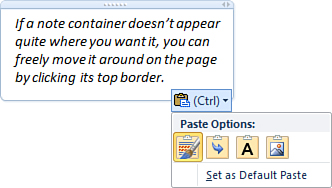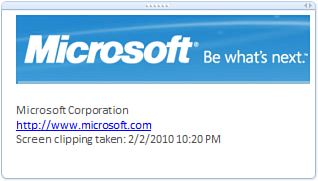Setting AutoCorrect Options
Like most Microsoft
Office programs, OneNote 2010 can automatically replace words or phrases
that you frequently misspell and correct them on the spot. For example,
if you type the misspelled word adn in OneNote, it will automatically correct it to and.
You can also use this
feature to assign text codes for long or complex phrases that you need
to frequently type. For example, you could have OneNote automatically
change “fmi” to the phrase “for more information” if this is something
you must frequently type.
To view or edit your AutoCorrect options, do the following:
1. | On the File tab, click Options.
|
2. | In the OneNote Options dialog box, click the Proofing category on the left side.
|
3. | On the right side, under AutoCorrect Options, click the AutoCorrect Options button.
|
4. | In
the AutoCorrect Options dialog box that opens, set the options you
want. In the double column list at the bottom, you can view the text
replacements that are currently in effect, and you can add new ones by
filling in the Replace and With fields and then clicking Add.
|
5. | To delete any entry that you no longer want to use, click to select it in the list and then click Delete.
|
6. | If you want to view or change the default AutoCorrect options for Math equations, click the Math AutoCorrect tab.
|
7. | Click OK to save any changes you made in either dialog box tab.
|
Showing or Hiding the Paste Options Button when Pasting
Whenever you paste text on a page in OneNote, the Paste Options button automatically appears (see Figure 3), letting you choose how the pasted text should be formatted.

Although a convenient
and useful feature, the Paste Options button can sometimes partially
hide or obscure text. If you find this annoying, or if you don’t care
how copied text appears in your notes, you can temporarily or
permanently turn off the Paste Options button by doing the following:
1. | On the File tab, click Options.
|
2. | In the OneNote Options dialog box, click the Advanced category on the left side.
|
3. | On the right side, under Editing, uncheck the Show Paste Options Button When Content Is Pasted check box.
|
4. | Click OK to save your changes.
|
Including or Suppressing Source Links when Pasting from the Web
Whenever you paste content from a
web page or you insert a screen clipping, OneNote includes a web link
back to the source page underneath the pasted content (see Figure 4). This lets you easily return to the source content if you need to find the original information again.

If you don’t find
this information useful or if you don’t want to reveal it to people with
whom you share your notes, you can suppress the automatic inclusion of
links by doing the following:
1. | On the File tab, click Options.
|
2. | In the OneNote Options dialog box, click the Advanced category on the left side.
|
3. | On the right side, under Editing, uncheck the Include Link to Source when Pasting from the Web check box.
|
4. | Click OK to save your changes.
|
Automatically Applying Numbers or Bullets to Lists
Though you can click
the Numbering or Bullets buttons on the Home tab to start either type of
list, OneNote can also automatically recognize when what you type
resembles a list.
For example, if you start a
new line by typing 1. followed by space and some text, OneNote will
assume you want to start a numbered list. Likewise if you type an
asterisk (*) followed by a space and some text, OneNote will assume that
you want to start a bulleted list. Typically, this is very helpful.
However, if you don’t want list formatting to be applied for you
automatically, you can turn this feature off by doing the following:
1. | On the File tab, click Options.
|
2. | In the OneNote Options dialog box, click the Advanced category on the left side.
|
3. | On the right side, under Editing, do either of the following:
|
4. | Click OK to save your changes.
|
Automatically Calculating Mathematical Expressions in Notes
OneNote includes a handy
little feature that’s affectionately called “napkin math.” When
enabled, OneNote will attempt to solve any simple mathematical
expressions that you type out on a page.
For
example, if you type 1+1= and then type a space or press Enter, OneNote
will correctly place the number 2 after the equal sign. You can solve
additions, subtractions, multiplications, and divisions in this way, and
you can combine any amount of numbers and operators for slightly more
complex calculations.
If you frequently type out
figures and you don’t want OneNote to solve anything that looks like a
math problem, you can turn this feature off by doing the following:
1. | On the File tab, click Options.
|
2. | In the OneNote Options dialog box, click the Advanced category on the left side.
|
3. | On the right side, under Editing, uncheck the Calculate Mathematical Expressions Automatically check box.
|
4. | Click OK to save your changes. |